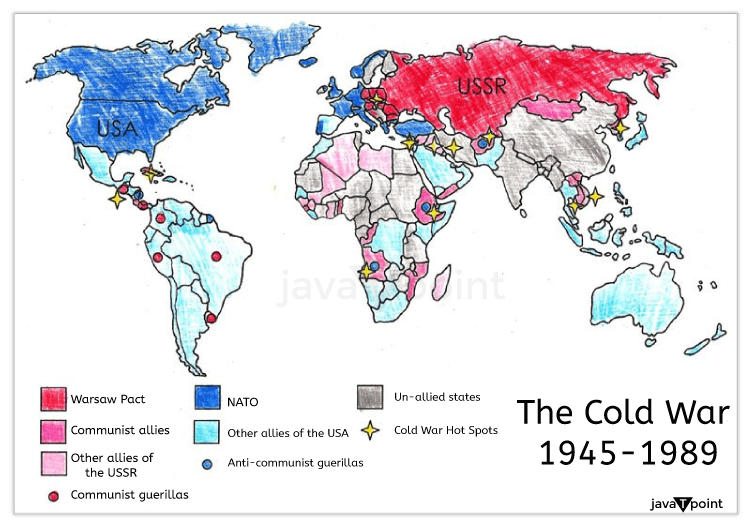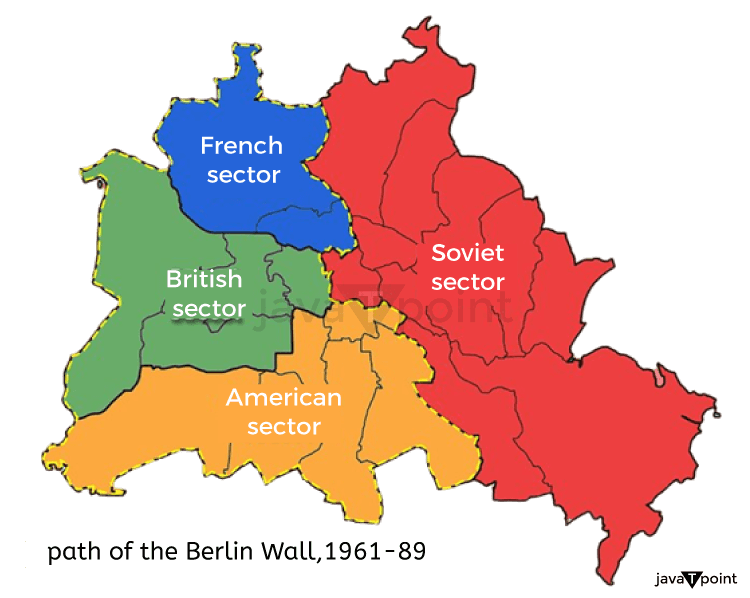Cold War SummaryIntroductionCold War was a preventive and restricted rivalry between the United States and the Soviet Union and the countries which are allies of respective groups; this rivalry evolved right after the Second World War. This geopolitical tension between the Eastern European Countries, i.e., the Soviet Union, and the Western European Countries, i.e., the United States, held during the period from 1945 to 1991; during this time, the world got divided into two powerful groups ruled by two superpowers of the world the Soviet Union and the United States. The term "Cold War" was first used in an article which was published in 1945 by the English writer George Orwell; according to his article, this war happened to be a nuclear standoff among "two or three huge states and that war can wipe or destroy millions of lives in an instant." Then this term is mentioned in a speech by Bernard Baruch, who was the American financer and Presidential advisor in the House of Columbia, South Carolina, in 1947. Note:

The Whole Struggle of SuperpowersStarting of Cold WarAfter the completion of the Second World War, Nazi Germany surrendered in May 1945; all the alliances of the United States, the UK, and France were on one side, and on the other side USSR, Germany, Japan, and Austria started to unravel, because there were multiple factors for the alliance. By the time of 1948, the Soviet Union had placed left-wing governments in the countries of Eastern Europe, which were liberated by the Red Army, the British and the Americans were concerned about the continuous Soviet control over Eastern Europe and feared that those parties which are influenced by the Soviets would come to power in Western Europe; on the other hand, the Soviet Union was desperate to preserve its domination in Eastern Europe to keep countermeasures against any thinkable new threat from Germany, and their other goal was to expansion of communism all over the world, mainly for ideological matters. During the period of 1947 to 1948 Cold War was solidified; the United States, with the help of the Marshall Plan in Western Europe, and with this U.S. brought those nations (Western European) under the domination of America, and the Soviets brought communist rule in Eastern Europe. Cold War at its PeakThe peak of the Cold War was in the years from 1948 to 1953; in this period, the Soviet Union and United States rivalry was at its peak, so the Soviet Union applied Berlin Blockade in 1948; Berlin Blockade was an effort by the Soviet Union by which it wants to restrict the ability of United States to reach in sectors of Berlin (they also built walls and did fencing known as Berlin Walls, see in the following image). To stop this from happening, the United States and European allies constructed the NATO (North Atlantic Treaty Organization); a united military command to oppose the interference of the Soviet Union in Europe in 1949; to show their dominance in Eastern Europe, the Soviet Union exploded their very first atomic bomb in 1949, by which the monopoly of America over atomic weapons is finished. In 1949, the Chinese communist came into existence, and the Soviet Union supported the communist government of North Korea in attacking South Korea, which was supported by the United States. That started the Korean War, which ended in 1953; more than 2.5 million people died on both sides. 
Special Note:
Seldom Relaxation in Cold WarDuring the time period 1953 to 1957, the strain between the United States and the Soviet Union during Cold War slightly decreased; this is because the Soviet leader Joseph Stalin died at that time in 1953, but the conflict remained. In the year 1955, an integrated military organization was formed by Soviet-bloc nations that are known as Warsaw Pact, and in 1955 West Germany joined NATO (North Atlantic Treaty Organization). Again, the intensity of the Cold War rose from 1958 to 1962; the Soviet Union and the United States started to build ballistic missiles in their nations; even the Soviets started to set up these missiles in Cuba, such that if it was completed, it becomes easy to attack the United States and its allies with nuclear weapons. Due to this, a new crisis was born in 1962 and was known as the Cuban missile crisis; this face-to-face encounter between the two superpowers led to the conditions of nuclear war; an agreement was signed by both groups to stop that upcoming nuclear war so that Cuba Missile crisis ends in late November 1962. The incident of the Cuban missile crisis brought up a matter that neither the Soviet Union nor the United States was ready to use nuclear weapons for their vengeance, so soon enough, the Nuclear Test-Ban Treaty was signed by both superpowers in 1963; which restricts the test of nuclear weapons above the ground, and it also provides instructions to the Soviet Union to not disgraced by the inferiority of their military power. So, the Soviet Union started to build up martial and traditional forces that the U.S. has to match (by force) for the upcoming twenty-five years (25 years). Note:
During the whole Cold War, the Soviet Union and the U.S. did not want to fight face to face in Europe; instead, both fought only to support their allies from changing sides or to overthrow them after they had done it. So in 1953, the Soviet Union sent its battalions to maintain communist rule in East Germany, in 1956 in Hungary, in 1968 in Czechoslovakia, in 1979 in Afghanistan, and on the other hand, the United States helped Guatemala in 1954 to overthrow a left-wing government, in 1961 took part in the failed invasion of Cuba, in 1965 invaded the Dominican Republic, in 1983 invaded Grenada, and in the period from 1964 to 1975 also tried to support South Vietnam so that it does not fall under the influence of communist North Vietnam but this was a failure. 
A New World OrderDuring the time of the 1960s and 1970s, the conflicts between the two groups, the Soviet Union and the United States, formed a tangled pattern of international relationships. In that pattern, the world was not divided into opposite groups; but a significant split occurred between China and the Soviet Union in 1960, which also increased throughout the years, breaking the unity of the communist group. While all this was happening, Japan and Western Europe obtained (achieved) dynamic economic growth in the 1950s and 1960s, by this, the gap between the economic growth of the U.S.A and Japan was reduced relatively, so we can say that the less powerful nations had quite a room to claim their freedom and seldom presented themselves hostile to the superpower outrage. In the 1970s, we saw a downfall in the tension of the Cold War, as both the superpowers, i.e., the United States and the Soviet Union were trying to negotiate that what should be the limit of antiballistic missiles and their nuclear load capacities, to do this, an agreement was signed by both superpowers known as SALT (Strategic Arms Limitation Talks), there were two agreements; first was signed in 1971 and second agreement was signed in 1972. Afterward, in starting of the 1980s, tension started to grow up between the United States and the Soviet Union because they were unable to decide the minimum capacity of nuclear weapons one should have, so both the superpowers continued to increase their nuclear weapons and started rivalry for dominating Third World. Note:
End of Cold WarIn the late 1980s, the Cold War started to dissolute as the new administrator of the Soviet Union 'Mikhail S. Gorbachev' started to break down the arbitrary phases of the Soviet communist system and started to democratize the Soviet political system in 1989 and 1990; when the communist system in the Soviet group countries of Eastern Europe begun to collapse, Mikhail Gorbachev was satisfied in the collapse of these nations. Thus, the democratic powers started to rise in Poland, Eastern Germany, Czechoslovakia, and Hungary, which led to the merger of West and East Germany under the guidance and protection of NATO with the Soviet's permission. Under the administration of Mikhail S. Gorbachev, the change in the communist system weakened the Communist Party, which changed the majority of power and shifted toward Russia and other countries in the Soviet Union, which were democratic or constituent republics. At the end of 1991, the Soviet Union broke down and split into fifteen (15) independent countries, including Russia, Ukraine, Latvia, Kazakhstan, etc.; thus, Cold War ended in December 1991. ConclusionAt the end of the Cold War in 1991, the world, which was divided into two groups or, say, bipolar world order, i.e., the United States and its allied countries and the Soviet Union and its allied countries, had turned into a single world order. However, in the past few decades, the unipolar position of the U.S., considered the world's most powerful state, now appears to be in a condition of instability. Due to its own mistakes, the invasion of Iraq and Afghanistan, instability of the global economy, and the dawn of new economic powers like India, Australia, Japan, China, etc., it appears that the downfall of the West is coming, and the rise of East is on its way. Important Knowledge
Next TopicMadame Bovary Summary
|
 For Videos Join Our Youtube Channel: Join Now
For Videos Join Our Youtube Channel: Join Now
Feedback
- Send your Feedback to [email protected]
Help Others, Please Share









